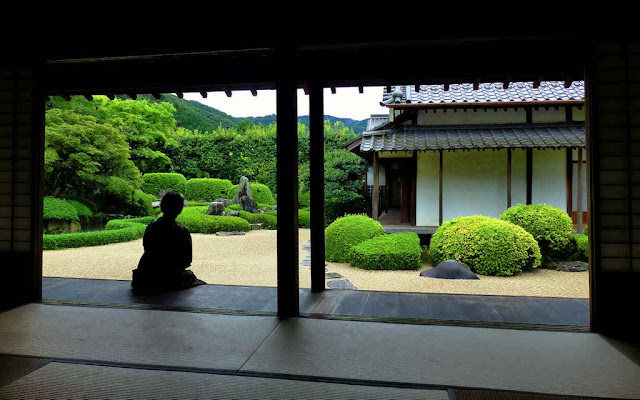Kiyama Temple is located at more than 400 meters above sea level on a mountain in the northern part of Okayama prefecture.
With a large torii at the entrance one might be forgiven for thinking that it was a shrine, and not a temple, but it is an example of what was very common in the old days, a religious site with elements of both Buddhism and Shinto, Shinbutsu.
In 1868 the government decreed that Kami and Buddhas were to be separated, a process akin to unscrambling eggs. This was done for ideological and political reasons, to create a "national" religion.
The founding legend says that Kobo Daishi himself was in the area in 815. An old woodcutter guided him to the mountain and suggested it was a good spot for a temple.
Kobo Daishi recognized the man as a manifestation of Yakushi Nyorai and founded the temple here with a Yakushi Nyorai statue.
I visited in early August after climbing up from Kiyama Shrine, and there was not another single person, visitor or staff, around the whole time I was there. Kiyama Temple is temple number 4 on the Chugoku Kannon Pilgrimage, and this was late on my fifth day of walking it.
The entrance is across a big lotus pond with a Benzaiten Shrine in the middle of it, photo 3.
Benzaiten is another deity that is problematic if you want to think in terms of a distinction between Buddhism and Shinto. Originally a Hindu deity, introduced into Japan by esoteric Buddhism, she later became a kami in Shinto.
The main gate, photo 4, here called Furomon, is said to be the oldest structure at the site, though I can't find an exact date for it.
The main hall also has a big torii in front of it. As well as Yakushi Nyorai, it also enshrined the two guardian deities, Gozu Tenno, and Inari.
Gozu Tenno was the deity of Gion-sha, the origin of the famous Gion Matsuri and now called Yasaka Shrine. Some sources suggest he was originally from India by way of Tibet and China, but most suggest a Korean origin for this deity.
Long equated with Susano, in 1868 the "kami" previously known as Gozu Tenno officially became Susano.
Inari as also a problem for those who think in terms of a pure, Indigenous "shinto".
There is no mention of Inari in the Kojiki and Nihongi, the texts seen as fundamental to "native" shinto. Inari is now equated with Ukanomitama, the post-1868 identity. rior to that Inari was often equated with Dakiniten, a Buddhist deity with Indian origins.
There are actually numerous secondary, small shrines to different Inari within the grounds of Kiyama Temple.
There is also a Koshin-do, a shrine to the Koshin deity, Daoist in origin, and very popular in pre-modern Japan, the Koshin cult brought us the Three Wise Monkeys, and the Sarubobo dolls.
Pictured above, the Kannon-do with its carved reliefs looks like a shinto honden, because that is what is was until 1868. It held the shintai that were moved to the new Kiyama shrine further down he mountain.
Pictured above, the Daishi-do was originally the main hall of the temple.
As well as Kobo Daishi it also enshrines Fudo Myo and Aizen Myo
So, a very complex mix of deities at this site, indicating a much richer and more diverse religious history than a simplistic shinto-buddhist duality.
There are some other large structures within the grounds, including a large guesthouse and storehouse, yet, as I mentioned before, not a soul around.



















































































